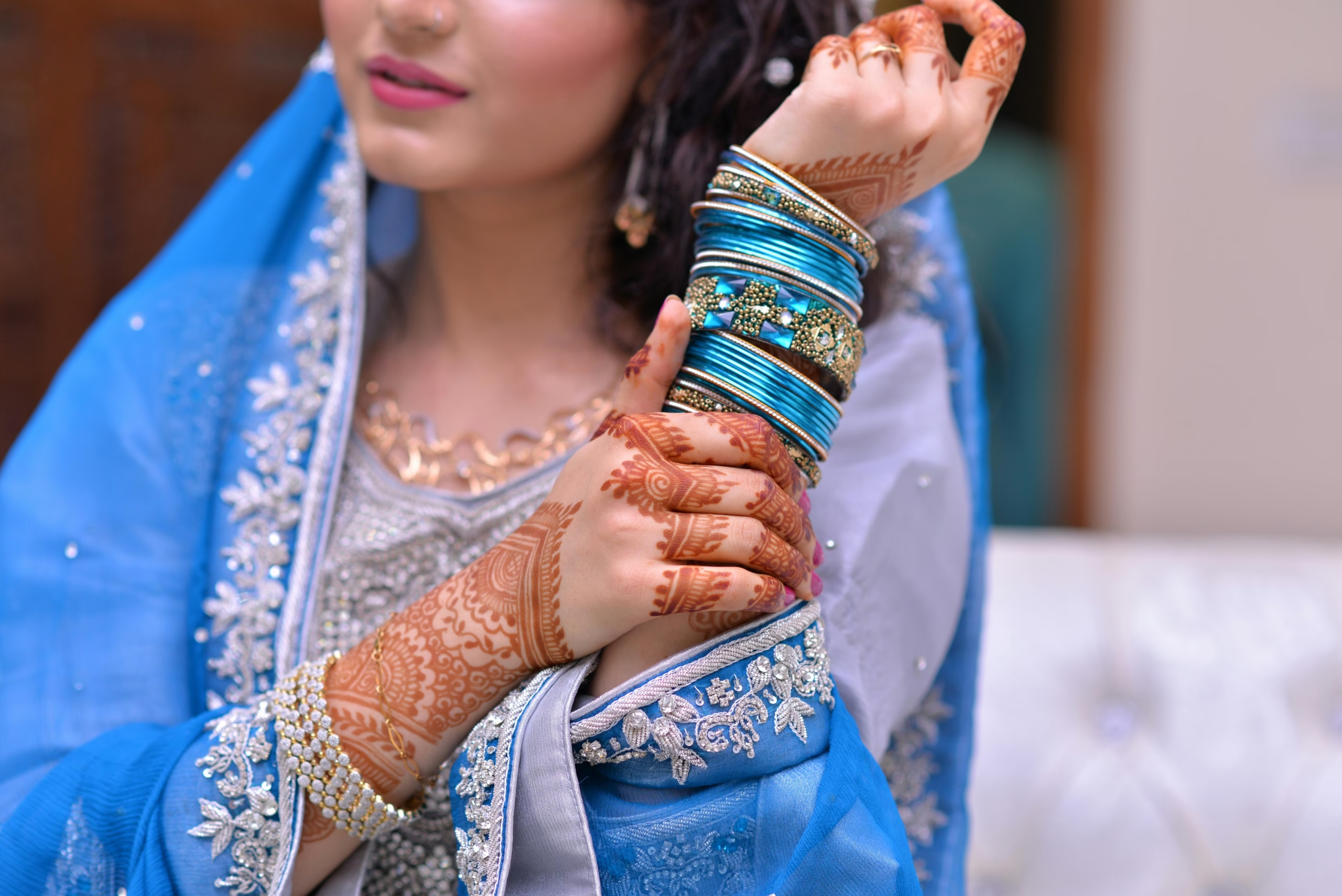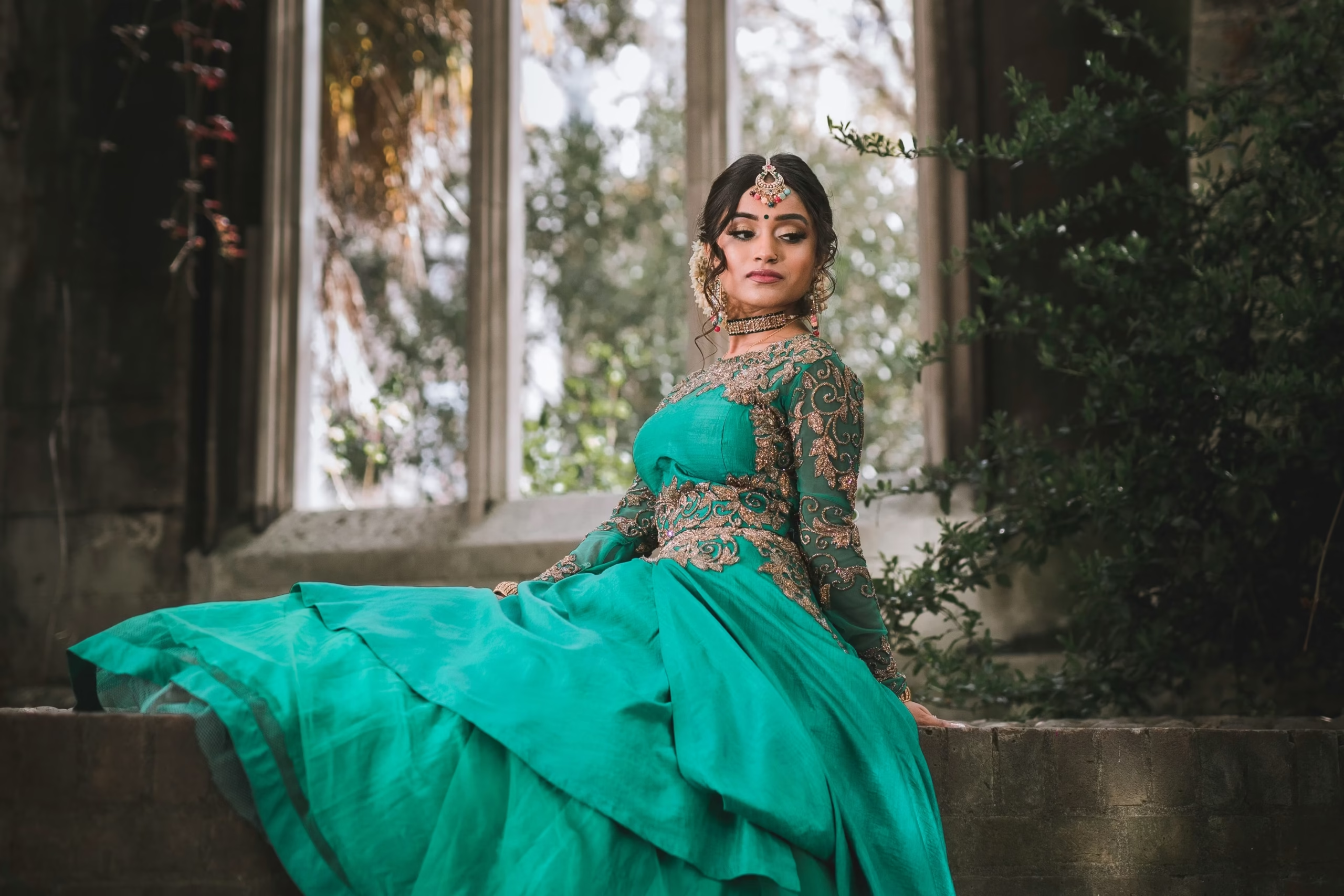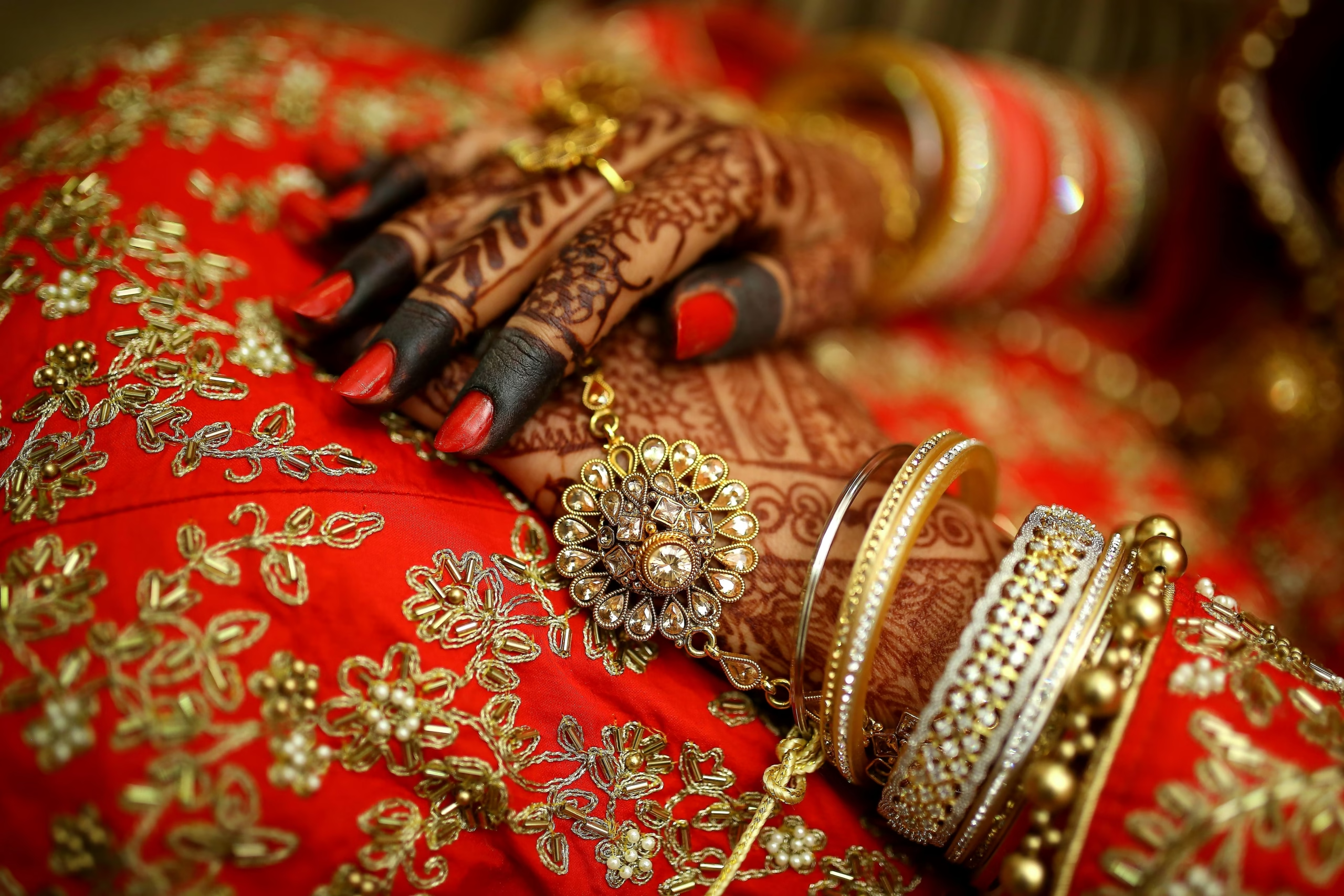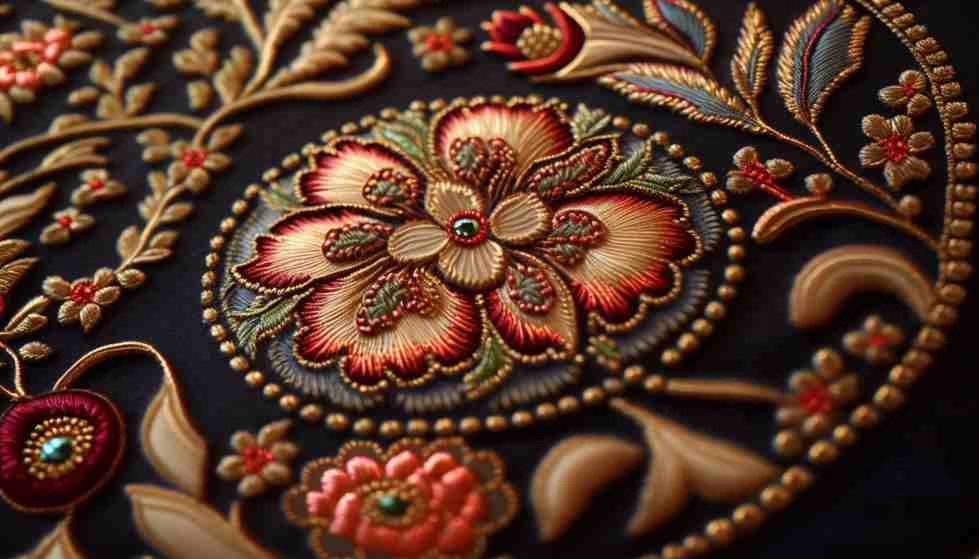Mughal dynasty art: Did you know it included embroidery, with gold and silver threads crafting stunning patterns on clothing during the Mughal Era? After the cloth was worn out, these threads were carefully removed and melted to be reused in jewelry. I bet you did not know about this. Such a practice showcases the extravagance of Zardozi but also its sustainable nature.
Have you ever seen images from the Mughal period art? The elegance and regality that shines through their dresses and attires is the Zardozi embroidery.
What is Zardozi? One might wonder. Zardozi comes from the Persian word Zardozi meaning ‘sewn in gold’. Typically, the Zardozi work comprises heavy metal embellishment done over rich fabrics like satin, silk or even velvet. The use of gold and silver wires, or coils is done to achieve opulence by creating a wide range of patterns such as elephants, peacocks, leaves, etc. In the Mughal dynasty, real gold and silver were used to be sewn on the fabrics, however, due to several different reasons, these days copper is used with gold or silver polish.
Zardozi embroidery is a very popular form of embroidery in Indian cities like Lucknow, Hyderabad, Bhopal, Barabanki, Unnoa, simply speaking it is a Mughal period art form that is mostly based in Uttar Pradesh. It has now become a form of luxury bridal wear not only in India, but also in Pakistan, Tajikistan, and neighbouring countries. This blog aims to offer you an overview of the history, techniques, and cultural importance of Zardozi. So, without further ado, let’s dive right into it!

What is Zardozi Embroidery?
You might have encountered the Bollywood movie Jodha Akhbar, starring Aishwarya Rai and Hrithik Roshan. In the movie Jodha, played by Aishwarya Rai, is seen clad in almost half a dozen lehengas with the zardozi work on it.
Now, that is from where the Mughal art of Zardozi was popularized. However, the art of Zardozi embroidery also commonly known as Zari these days, originated in Persia and travelled all the way to India along with the craftsmen who came to the courts of the Mughal rulers to showcase the art and grandeur of embroidery. The motifs, symbols, and patterns used to create the magnificence are a blend of Persian and Indian aesthetics with Turkish accents. The masses during the Mughal era used Zari, the thread created from gold and/or silver to embellish and enhance the beauty of their clothes, furnishings, horse saddles, etc.
Most of the Mughal kings were patrons of art, especially Akbar, hence they not only supported the art of Zardozi embroidery but also made it a symbol of the royal art form. During those times only the aristocracy and the royals could own something with Zardozi on it, thus it became a royal attire for the Mughals and the art of Zari embroidery flourished under the rich patronage of Akbar.
After the 17th century, the Mughal period art form of Zardozi was still so in trend that it was later patronized by the Nawabs of Lucknow, Agra, and the surrounding regions. Today, even though the craft is diminishing, Lucknow is still considered one of the finest hubs for Zardozi.

What are the techniques and Materials used in Zardozi Embroidery?
Zardozi is no longer seen as just a form of embroidery, it has now become an art form. It is an art form that not only needs delicate hands but also dedicated hands, skillfully weaving each Zari into the base fabric and creating designs that tell the tales of hundreds of years ago. The Zari weavers weave a legend from the Mughal dynasty. They use several different techniques and processes to get that enticing piece of art to take the form of the dreams of thousands of Indian brides. Have I mentioned this before? The Zardozi embroidery is a popular choice for Indian bridal wear. Stay tuned to know more about Zardozi!
Let us now take a look at the two main styles of stitching followed by craftsmen almost all over India. These comprise the Karchobi and the Kamdani forms of stitching.
The Karchobi style of stitching in Zardozi embroidery is dense, and thick and often used over heavy base fabrics such as satin and velvet. However, the Kamdani style is the opposite, it is fine, dainty, and more elegant. It is used mostly on soft fabric bases such as silk and muslin.
The Karchobi style is also said to be used on coats, furnishings, etc. While the Kamdani style of stitching in Zardozi embroidery is often used on dupattas, veils, and lehengas, and is popular as luxury bridal wear in India. Some of the other stitching techniques followed by Zari craftsmen that are worth mentioning include the Badla, Salmais, Dabka, Asitara, and Gijai.

What procedure is followed in the creation of the Zardozi embroidery? One might wonder. Let us break it down for you. There is a very simple and basic 4-step technique that is heeded in the making of the royal embroidery.
- The first step is designing. In this initial stage, the design is carved on the base fabric using a needle. Holes are created along the edges of the pattern, this pattern is first drawn on a tracing sheet and later transferred to the fabric through this process. Nowadays, geometrical shapes and a wide variety of different motifs are used in the patterns, however, during the Mughal era, these patterns were far more complex including natural motifs like leaves, flowers, fauna, etc., and also time-consuming to create.
- The next step or the second stage in the making of the regal Zardozi embroidery involves the tracing process, which we discussed above. However, let me make it clear to you now! So, in this step, the base fabric is spread on a flat table and the sheet with the drawing of the design is placed above the fabric, this is done to transfer the design or pattern onto the fabric. For clean and neat transference, pieces of cloth are dipped in a solution of Kerosene and Robin blue, and then wiped over the sheet, this allows the solution to seep onto the fabric.
- The third stage in Zardozi embroidery is setting the frame. After the tracing is completed, the fabric is stretched over a wooden frame also known as the Adda. The length and width of the frame are adjusted according to the size of the fabric, and using wooden spars, the fabric is stretched out. This is the most crucial stage, as it provides the fabric with equal tension, with no lumps or bumps! In this stage, the tightly held fabric becomes the canvas for the artisans to create the most beautiful and elegant embroidery ever witnessed by humankind. Here begins the actual art of weaving or embroidery. Now, isn’t it an art form, quite literally?
- And finally comes the last and most awaited stage of embroidery. Once the fabric is evened out, the craftsmen begin their creation. For the embroidery purpose, the artisans use a needle that is closely similar to an ordinary crochet needle, which is attached to a wooden stick, also known as an Ari. This Ari, or wooden stick actually proves to be very useful for the craftsmen as it helps them by increasing the speed of their work. With the use of the Ari, it is possible to pass the thread above as well as below the base fabric. As we know the patterns in Zardozi embroidery are complex and intricate, this process may take around 5 to 10 days to get the entire design concrete.
These were the 4 stages of the creation of Zardozi embroidery over a piece of fabric. Now, talking about the technique, it also requires a set of tools, right? Let’s take a look at that and the materials that are commonly used, too.
The Ari, that we discussed above is a needle with a wooden handle that helps the artisans to work efficiently. Then comes the Adda, also mentioned above, which is a wooden frame that allows to fully stretch the fabric and create equal tension. Next, we have some paraphernalia, comprising needles, to stitch the beads; a bobbin, also known as a spindle that helps to gather the thread, a pair or two of scissors, the tracing sheet, which plays an important role in the creation of designs, sequins, beads, different kinds of stones, etc. all add to the extravagance of the design.
Decline and Revival of this Mughal Dynasty Art Form
As we have seen, the 15th century, or more precisely the reign of emperor Akbar marked the glory of the Zardozi craft. However, with the loss of royal patronage in the later years, with the decline of the Mughal dynasty came the downfall of Zardozi. The artisans had to flee in search of a better livelihood because the unexceptionally high cost of raw materials was something they could not afford with meagre wages. Nevertheless, this was just the first blow to the heightened glory of Zardozi, the next was yet to come. With the British, different kinds of machines and types of equipment came to India.

The advent of industrialization in the Western world had also taken Indian markets by storm during the 17th and 18th centuries. The rise in demand for newly launched ready-made clothes, and the surge in fame of minimalism also led to a decline in the demand as well as the opportunity for growth for Zardozi. This was the next blow to the established reputation of Zardozi as a form of royal embroidery. Nonetheless, it turned out to be the last one. With the independence of India came the recovery or revival of various art forms that were once forgotten including Zardozi and other kinds of embroidery.
Zardozi, in the Mughal period, was done using real wires made from gold and silver, however, with the changes in economy, these days copper wires and coloured threads are used to weave the Zardozi patterns. But this does not hold back the embroidery from shining and gaining attraction. In fact, Zardozi is not only used on bridal wear to adorn new brides but it is also used on the ramps with some of the top models clad in Zardozi!
End Note
So, wrapping this blog up, hoping that this blog on Zardozi embroidery has shed some light on your quest to find out more about royal embroidery in Mughal India. In today’s world, with globalization and growth in e-commerce, zardozi embroidered fabrics, sarees, and dresses have gained immense popularity not only in India but also in other parts of the world.
Zardozi has become culturally significant because of its association with royalty dating back to the 13th and 14th centuries. The history, and roots of zardozi make it precious and something that should be preserved and perpetuated to the coming generations. It has already become an integral part of the cultural heritage in cities like Lucknow and Agra. Often used in bridal attires in India, this Mughal period art form of embroidery was and still is a symbol of status and luxury.
The intricacy of the patterns and designs, the use of valuable metals such as gold and silver, and rare stones to create them. The incorporation of not only flora and fauna, but also the architecture, and art style, all of these carry some meaning to it. Hence, it has become the identity of a few families where this art form is passed down through generations as a tradition.
For further reading on significance of Zardozi, you can visit these useful resources:
Check out our Blog Page on Traditional Indian art.



Leave a Reply